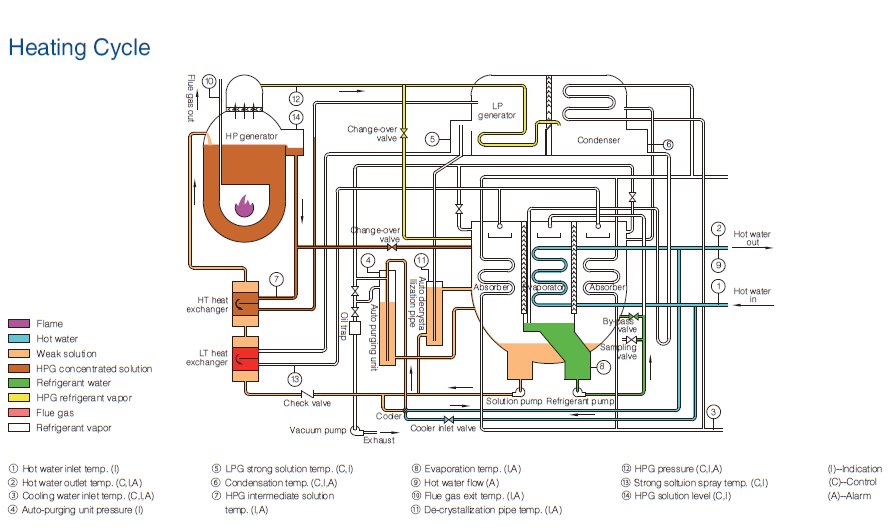

ENRGISTX, the USA Distributor for Shuangliang Eco-Energy, announces a breakthrough in absorption chiller performance and reliability, for CoGeneration and natural gas-fired absorption chillers. The new J Series high-efficiency absorption chillers recover from 15-25% more waste energy and improve the overall fuel system efficiencies of cogeneration or trigeneration to well over 90%.
What is CoGeneration and Why is it Important?
Distributed power generation, utilizing natural gas (or biogas) in a Combined Cooling Heating and Power (CCHP) onsite facility, has many advantages for business and the environment over utilizing power from the utility providers. As detailed by the US Department of Energy Office of Energy Efficiency and Renewable Energy, CCHP benefits include:
- “Enhances our energy security by reducing our national energy requirements and help businesses weather energy price volatility and supply disruptions”
- “Advances our climate change and environmental goals by reducing emissions of CO2 and other pollutants”
- “Improves business competitiveness by increasing energy efficiency and managing costs”
- “Increases resiliency of our energy infrastructure by limiting grid congestion and offsetting transmission losses”
- “Improves energy efficiency by capturing heat that is normally wasted.”
Reducing Carbon Emissions – Improving Our Environment
Under the previous administration’s Executive Order “ACCELERATING INVESTMENT IN INDUSTRIAL ENERGY EFFICIENCY,” the goal set for a 50% increase in CCHP capacity by 2020 would save $10 billion per year when compared to current energy use, and reduce emissions by 150 million metric tons of carbon dioxide (CO2) annually.
Current CHP systems have efficiencies of 65-75%, far greater than the national average of ~50% efficiency of the power grid. In CCHP, absorption chillers are added to the systems to provide “free cooling” by utilizing more of the waste heat off of the generator, increasing system efficiencies to ~85%.
Yet, there is still waste heat unrecovered from the combustion process, and Shuangliang Eco-Energy has announced the J Series Absorption chiller to maximize the energy utilization from this waste heat, delivering total system efficiencies well above 90%.
The Challenge:
Performance characteristics of current absorption chillers limit CCHP performance
- Limit on the flue-gas exhaust temperature leaving the chiller, restricting heat recovery and wasting usable energy, thereby limiting performance.
- Limit on the jacket water return temperature from the chiller, limiting the recoverable energy from the jacket water, which is dumped into the atmosphere via the radiator, thereby limiting performance.
Why is this the case?
Since all absorption chiller, Original Equipment Manufacturers are outside the United States, they design their absorption chillers to the standard shipping container sizes available. This restricts the size of the chiller, and since an absorption chiller is primarily a large heat exchanger, the more surface area available, the more heat transfer that can be accomplished. When there are limits on size based on shipping containers, this limits the tube surface area available, which restrict the heat transfer capacity.
For example: based on the above constraints, most manufacturers limit the flue-gas exhaust temperatures to 320°F, and jacket water no lower than 176°F return to the generator. Reciprocating generators can have return jacket water requirements as low as 155°F. The difference of 21°F is wasted energy and dumped into the atmosphere through radiators.
The flue-gas exhaust leaving temperature from the chiller is normally designed around 320°F regardless of the entering temperature, which varies from 500°F-950°F. Again, these are arbitrary conditions set by the absorption chiller manufacturers to recovery as much energy as possible, keeping the size of the chiller within shipping container constraints.
Shuangliang Eco-Energy has redesigned their CoGeneration and Direct-Fired absorption chillers to maximize the waste energy utilization, unbounded by the above limitations, thereby increasing cooling performance by up to 25%.
The breakthrough J Series Double Effect Absorption Chiller achieves an industry leading Coefficient of Performance (COP) of 1.456 for the Direct-Fired models, 1.45 COP for Flue-Gas, and a 1.55 COP for the Double Effect Steam models.
For example: The J Series standard flue-gas exhaust leaving temperatures can operate at 120°C / 248°F, reclaiming 72°F of heat energy through the absorption cooling process (under certain allowable conditions and models, the exhaust temperatures can be reduced to 100°C / 212°F, reclaiming even more heat.) Jacket water temperature differentials can range up to 60°F.
The J Series will recover from 15-25% more waste energy, and improve the overall fuel system efficiencies of the cogeneration or trigeneration to well over 90%.
To accommodate shipping and ground transport in the US, the larger models ship in hermetically sealed sections able to fit on standard shipping containers and are then assembled in the field.
In addition to the J Series breakthrough in efficiency, all Shuangliang Eco-Energy absorption chillers share unique design benefits which have proven, with over 30 years in the field, to deliver longer system life and improved reliability:
- Shuangliang design utilizes water tube generator sections vs. fire tube sections. The water tube design allows for the higher temperature differentials and less thermal stresses vs. the very long tubes in the fire tube design.
- The internal flue-gas pressure drops are significantly less than those of the fire-tube design, thereby leading to greater reliability and longer system life.
